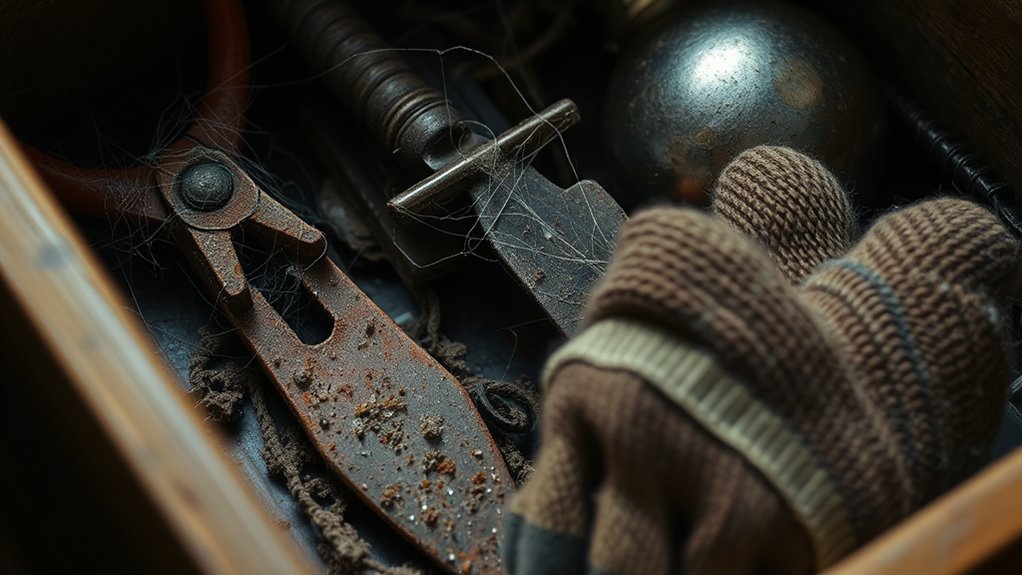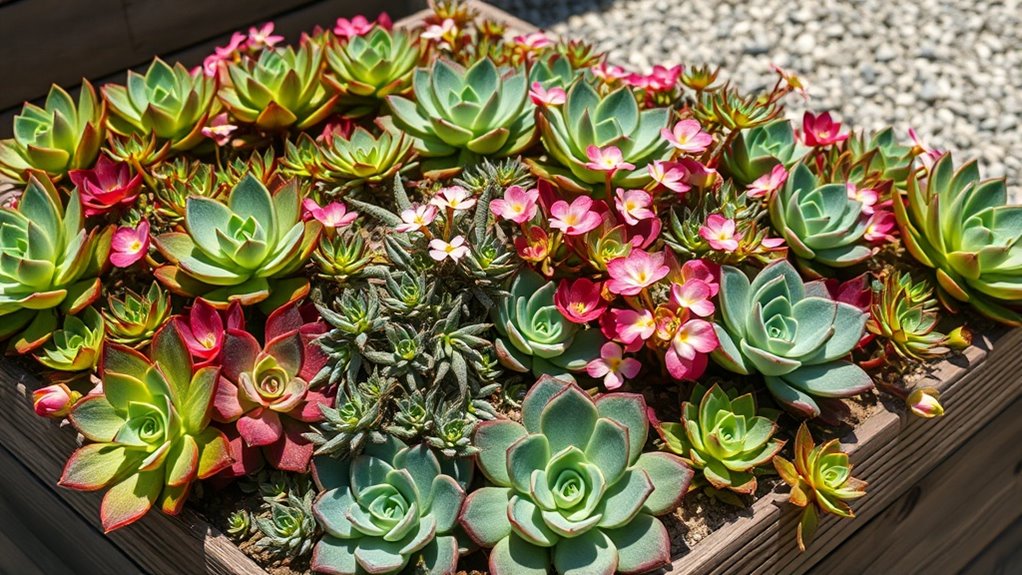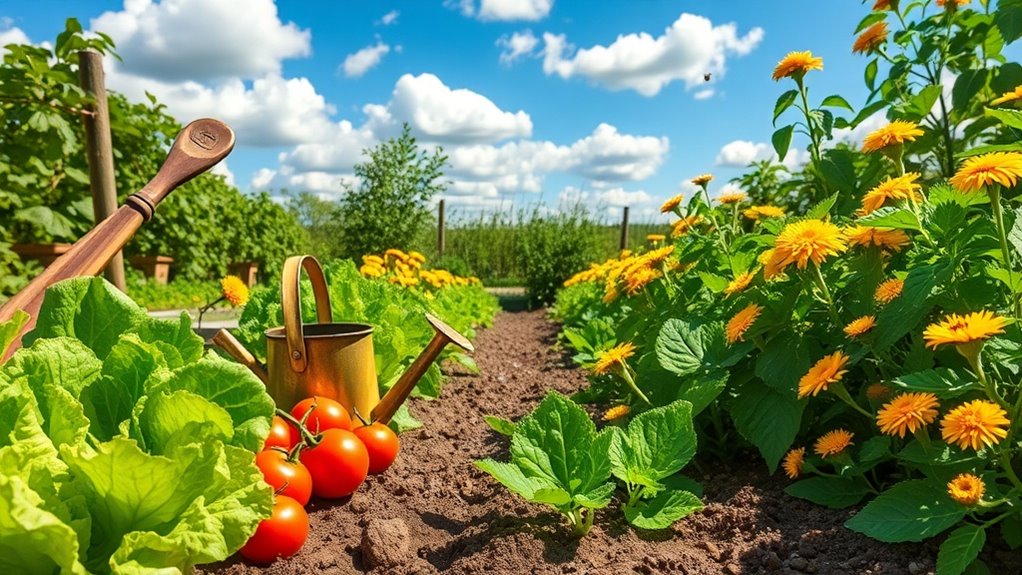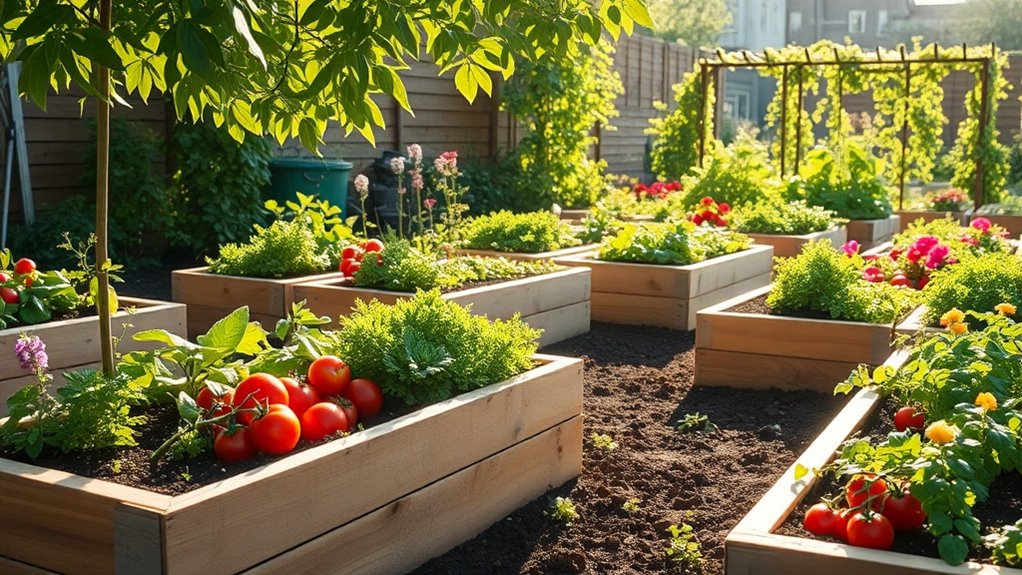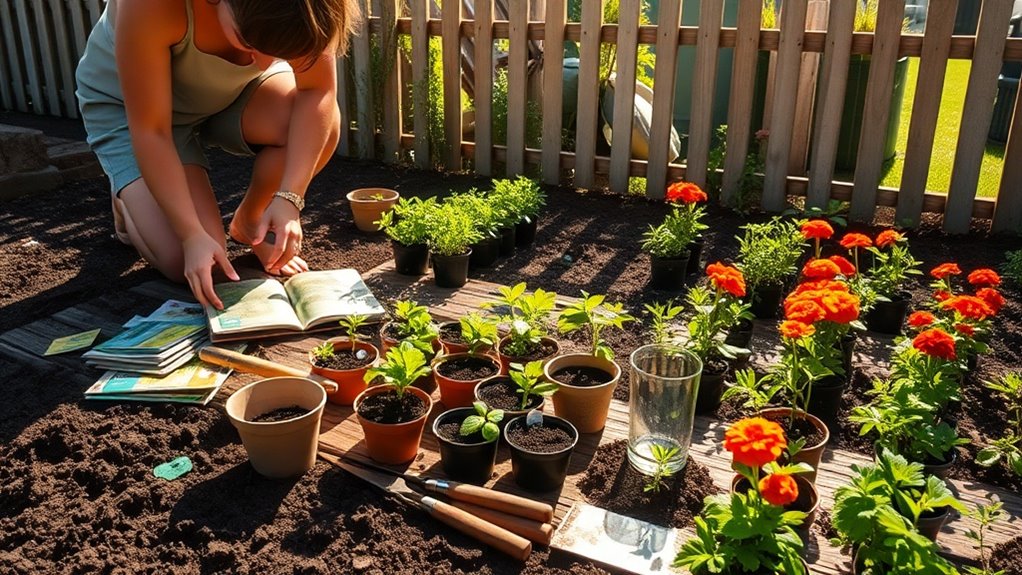What’s Really Hiding in Your Garden Tools Drawer.
In your garden tools drawer, you’ll uncover rusty pruners, tangled twine, forgotten seed packets, and misplaced gloves, all posing hidden risks like sharp edges that cause cuts or corrosion that weakens metal. Regularly inspect and clean these items using a stiff brush, mild soap, and oil to remove debris and prevent rust buildup. Check handles and blades for damage to ensure safety during use. By tackling these surprises head-on, you’ll master maintenance techniques that keep your toolkit sharp and reliable.
Key Takeaways
- Rusty pruners and forgotten seed packets often lurk in garden tool drawers, signaling the need for regular checks.
- Misplaced gloves and tangled twine can create clutter and hazards, making inventory essential for safety.
- Chemical residues on tools may hide and pose health risks, requiring thorough cleaning after use.
- Early rust signs, like reddish-brown patches, indicate potential damage that demands immediate attention.
- Poor storage practices lead to hidden dangers, such as sharp edges, emphasizing organized and ventilated spaces.
Unearthing Forgotten Items
Have you ever opened your garden tools drawer and uncovered items you’d long forgotten? That’s where a gardening gear check proves invaluable. You begin by emptying the drawer and inspecting each tool for usability, noting any overlooked pieces.
This practical process helps you catalog forgotten items, ensuring your toolkit remains efficient. During your gardening gear check, assess handles, blades, and storage to prevent rust or damage.
Common Surprises in the Drawer
When you open your garden tools drawer, you’ll often discover unexpected items like rusty pruners, forgotten seed packets, or even misplaced gloves that have been hiding for seasons.
These surprises accumulate from hurried storage after use, turning your drawer into a cluttered archive. You’ll find tangled twine, outdated plant labels, or stray nails that migrated from other projects, potentially dulling sharp edges or harboring pests.
Such items signal the need for periodic inventory to maintain organization, ensuring your tools remain functional and ready for the next gardening task without unnecessary hazards. To enhance your gardening success, always ensure your drawer includes essential tools that seasoned gardeners rely on.
By following essential care tips, you can prevent these surprises and ensure your tools are always prepared for the growing season.
Essential Cleaning Techniques
You handle cleaning basics for your garden tools by removing dirt and debris immediately after use to prevent buildup.
Then, you apply maintenance methods like drying and oiling surfaces to avoid rust.
This approach ensures your tools stay effective and last longer.
Proper maintenance allows these tools to function as part of the three essential gardening tools that enhance garden efficiency.
Additionally, these techniques are particularly beneficial for budget-friendly gardening tools to maximize their value and performance.
Cleaning Basics
Effective cleaning basics for garden tools involve simple yet essential techniques that maintain their longevity and performance.
You start by gathering supplies like a stiff brush, mild soap, and clean rags.
Begin with dry brushing to remove dirt and debris from surfaces. Soak metal tools in warm, soapy water, then scrub gently to eliminate grime.
For wooden handles, wipe with a damp cloth to avoid warping. Rinse everything thoroughly under running water.
Dry tools completely with a rag, focusing on joints to prevent moisture buildup. This routine ensures your tools stay clean and functional.
Maintenance Methods
Building on cleaning basics, you regularly oil metal surfaces to ward off rust, sharpen blades with a fine file for optimal cutting, and inspect handles for wear to ensure tools remain reliable and ready for use.
It’s crucial to integrate these techniques into your routine for long-term tool health. Here’s how they deepen your maintenance approach:
-
Oiling wards off moisture: By applying light oil, you’re creating a barrier that prevents corrosion, preserving metal integrity for seasons ahead.
-
Sharpening boosts efficiency: You maintain a keen edge, reducing strain and ensuring clean cuts that promote plant health.
-
Inspecting prevents failures: Regularly checking handles lets you spot cracks early, avoiding accidents and extending usability.
Rust Prevention Strategies
Rust prevention is essential for maintaining garden tools in a drawer, as moisture and air exposure often accelerate corrosion.
You’ll protect your tools by applying a thin coat of oil, like WD-40 or mineral oil, after each use to create a barrier against humidity.
Store silica gel packets in the drawer to absorb excess moisture, keeping the environment dry.
Regularly inspect tools for early rust signs and wipe them down immediately. Incorporating time-saving tools can help make rust prevention more efficient.
For high-risk items, consider protective sprays or wax coatings that seal surfaces effectively.
These steps extend your tools’ lifespan and ensure they’re ready when you need them.
Additionally, for enhanced protection, explore smart gardening tools that may include features designed to reduce maintenance issues like rust.
Organizing Your Gear Effectively
While rust prevention keeps your tools in top condition, organizing your gear effectively ensures quick access and minimizes wear in your drawer. Additionally, integrating revolutionary tools can make gardening tasks quicker and more enjoyable for enthusiasts.
You’ll maximize space and efficiency by categorizing items, using dedicated holders, and conducting regular audits.
-
Categorize by function: Group tools like pruners with cutters to reduce search time and prevent damage from mismatched storage.
-
Utilize modular dividers: These adapt to your drawer’s size, keeping edges protected and promoting airflow to avoid unnecessary friction.
-
Implement a maintenance schedule: Regularly rearrange to distribute weight evenly, ensuring longevity and easy maintenance without added stress.
To enhance your gardening experience, incorporate innovative tools that simplify planting and make the process more enjoyable for beginners.
Hidden Dangers to Watch For
As you organize your garden tools, you’ll encounter rust and corrosion that weaken metal components over time.
Sharp tool hazards demand careful handling to prevent cuts and injuries during use.
Chemical residues on surfaces pose health risks, so you must clean and store items properly.
Rust and Corrosion
One key threat to your garden tools is corrosion, which silently eats away at metal surfaces and weakens their structure over time.
You’re likely dealing with it if your tools show pitting or flaking, caused by moisture and oxygen exposure. To combat this, focus on prevention and maintenance to extend your tools’ life and ensure safe use.
-
Identify early indicators****: Spot rust as reddish-brown patches that signal metal degradation, allowing you to act before tools fail.
-
Control environmental factors****: Store tools in dry, ventilated areas to minimize humidity, which accelerates corrosive reactions.
-
Apply protective measures: Regularly coat metal with oil or rust inhibitors to form a barrier, preserving strength and functionality.
Sharp Tool Hazards
Sharp tools in your garden kit pose serious injury risks that often go unnoticed, so you’ll want to stay vigilant for hidden dangers like accidental cuts or slips during use.
Always inspect blades for excessive sharpness or damage that could lead to uncontrolled movements. When handling pruners or shears, maintain a firm grip and position tools away from your body to avoid mishaps.
Wear protective gloves and eye gear to shield against flying debris. Regularly sharpen tools correctly using a file or stone, but never when fatigued, as this heightens error risks.
Proper storage in designated cases prevents unintended access, keeping your workspace safer.
Chemical Residues
Chemical residues on your garden tools can linger from pesticides or fertilizers, creating hidden health risks like skin irritation or poisoning.
You’re exposing yourself to these dangers every time you handle untreated tools, so take proactive steps to identify and eliminate them. Regular inspection and thorough cleaning aren’t just good habits—they’re essential for your safety.
-
Inspect thoroughly: Examine tools for sticky coatings or unusual odors that signal residue buildup, helping you spot hazards before they cause harm.
-
Clean effectively: Use a mild detergent and water, followed by rinsing and drying, to neutralize chemicals and prevent absorption through your skin.
-
Store properly: Keep tools in a sealed container away from moisture, reducing residue persistence and maintaining a safer environment for future use.
DIY Repair Essentials
When maintaining your garden tools, you’ll need a set of DIY repair essentials that keep them in top condition. For those new to gardening, investing in essential gear can help ensure a smooth start.
Start with a basic toolkit: screwdrivers and pliers for disassembling handles, a wire brush and rust remover for cleaning metal parts, and sandpaper for smoothing edges.
Include lubricating oil to prevent rust and seizing on moving components. For blades, add a sharpening stone or file to restore edges quickly.
These items enable on-the-spot fixes, ensuring efficiency and safety. Regularly inspect tools and use these essentials to address wear, prolonging their usability without professional help.
By incorporating these practices, you can enhance garden efficiency and achieve greater overall success in your gardening endeavors.
Seasonal Preparation Tips
As the seasons shift, you’ll need to ready your garden tools for optimal performance and longevity. Start by cleaning tools to remove debris and prevent rust, then sharpen edges for precise cuts and inspect for damage to avoid accidents. These steps ensure your equipment withstands weather changes effectively. Properly maintained tools are essential for effective soil preparation tasks that support thriving plants. To further enhance your gardening success, consider assessing soil health as a foundational step in your overall preparation.
-
Assess seasonal impacts: Evaluate how temperature fluctuations affect metal and wood, promoting proactive maintenance to extend tool life.
-
Protect against elements: Apply rust inhibitors and lubricants to combat moisture, fostering durability and reducing repair needs.
-
Optimize for transitions: Test tools under simulated conditions to identify weaknesses, enhancing reliability for upcoming gardening tasks.
Creative Storage Ideas
Efficient storage transforms your garden tools from clutter to accessible assets. You install pegboards on walls to hang items like trowels and pruners, maximizing space and minimizing rust.
Use drawer dividers to separate small components such as seeds, gloves, and twine for quick access. Opt for modular shelving that adjusts to fit various tool sizes, offering flexibility.
Integrate labeled bins with RFID tags for efficient inventory tracking. Add wall-mounted racks for larger tools like shovels, ensuring stability.
Regularly maintain these setups with moisture-resistant materials to extend tool life and enhance your gardening workflow.

